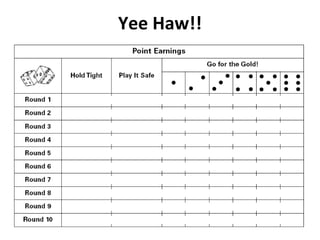
Causes Of The Great Depression
- 1. Yee Haw!!
- 3. Causes of the Great Depression
- 5. Even those who played it safe lost their credit Point values decreased dramatically, all but those who held tight lost everything they had and sometimes more Some students bought bonanza chips Students selected the “Go for the Gold” option Stock Market Crash 1929 Yee Haw
- 8. The Stock Market Crash of 1929 The business sells two shares of stock for $100 and invests it in land. The businessman has $0 The land that the business bought was overpriced because of speculation and becomes worthless. The business no longer has enough money to operate. The recipient takes a $100 loan from the bank. The recipient has $100 . The recipient buys two shares of stock for $50 each. The recipient has $0. Buying with loaned money is referred to as buying on the margin. Speculation causes stock prices to rise to $75. The recipient takes another $150 loan. And buys two more shares of stock. The recipient has $0. European investors get nervous and start selling their stock investments. As prices fall, they gain momentum. The recipient attempts to sell all four of his stocks for $25 each, for a total of $100. The bank gives a $100 loans for $20 up front. The bank has $20. The bank gives a $150 loan for $30 up front. The bank has $50 The Business The Borrowers The Banks
Editor's Notes
- Bull Market = steadily rising market. People thought it would last forever. Speculation = Prices went up, as people tried to make quick profits. Stock prices had little to do with how valuable the company really was. When prices began falling, people panicked and rushed to sell.
- Mass production was too successful. Not enough consumers. New technologies and techniques improved farming production as demand decreased. Overproduction = products not selling. Underconsumption = people were not buying as much as was being produced. Farmers had made money supplying food for the Allies during the war. Consumption dropped, so did prices, resulting in less income for farmers, who then turned to credit to buy the consumer items of the day. For the first time in history the number of farmers decreased. Livestock slaughtered in attempt to control prices. Business, dwindled, companies cut back, so declared bankruptcy (sound familiar). Unemployment grew, leave people with debt and no money to consume. As businesses boomed in the first half of the 20s, workers saw gradual increases in their wages, but it still wasn’t enough to solve overconsumption. 1929 top 1% controlled 56% of the wealth, bottom 99% controlled 44% People compensated for the unequal distribution of wealth by buying on credit. When the wealth in concentrated, it prevents most of the people from buying stuff.
- Germany had to borrow money from the US to pay off reparations to the Allies. Therefore, The Germans needed to sell stuff. To protect American business from foreign competition, Congress passed the Hawley-Smoot. In reaction, European countries, raised their own tariffs. Businesses with surpluses couldn’t sell their extra stuff to foreign markets.